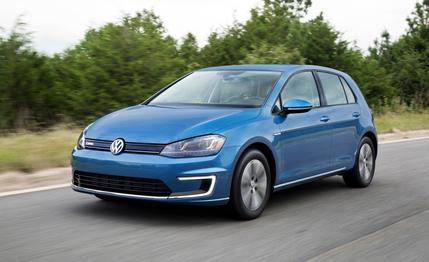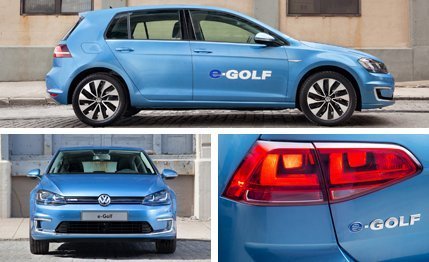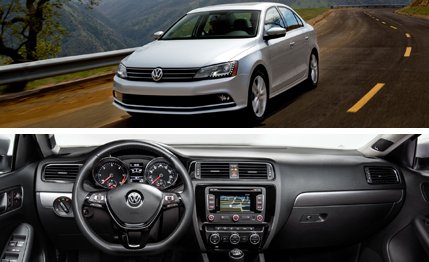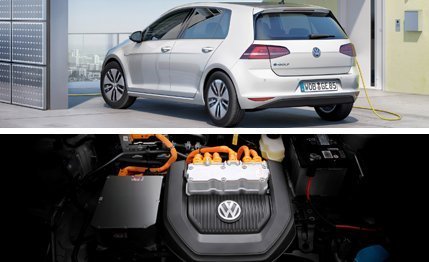
 First Drive Review
First Drive Review
In case you’re keeping score, when we close the books on calendar-year 2014 there will be 13 distinct pure-electric automobiles for sale in the United States. And for the first time, one of them will be wearing the familiar VW badge.
As with almost all other electric cars besides the Nissan Leaf and the Tesla Model S, the e-Golf is an adaptation of a car available with an internal-combustion engine. Unlike the others, the electric Golf benefits from VW’s modular MQB architecture, designed to accommodate a range of vehicle types and powertrains. And unlike the Leaf, a versatile platform supporting a unique product, the electric Golf works hard at looking like the other members of its extensive family. Cosmetic distinctions are fairly subtle, limited to LED headlamps and running lights, modest badging, special 16-inch wheels, a revised front-grille shutter, a unique rear spoiler, and C-pillar air vanes.
In addition to having it look like a garden-variety Golf, the development team wanted the e-Golf to drive like one, and in general they’ve been successful. In Normal mode, the e-Golf has the dynamic persona of its internal-combustion siblings, with a firm suspension, limited body motions, better-than-average transient response, and moderately brisk acceleration.


The 264-cell, 24.2-kWh, lithium-ion battery pack weighs 688 pounds, and even though the absence of a conventional engine mitigates that mass to some extent, the e-Golf is almost 370 pounds heavier than a basic Golf five-door automatic, according to VW.
Electric motors give everything they’ve got from the first rpm, but there’s not as much motive power on tap as in the standard Golf’s 1.8-liter gasoline turbo four. Torque is about even (199 lb-ft for the e-Golf, 200 on dinosaur juice), but the gas engine has a big edge in horsepower, 170 versus 115. So while the e-Golf gets out of the blocks without hesitation, arriving at 60 mph takes a claimed 10 seconds or so. On the other hand, VW says the e-Golf can reach 30 mph quicker than a GTI, which would mean about 2.5 seconds.
Eco Ops
So far we’re talking about Normal mode. But the e-Golf has other operating parameters to optimize the duration of its battery charge. For example, there are Eco and Eco+ modes, which successively limit horsepower and top speed, from a Normal max velocity of 87 mph to 56 mph in Eco+. There are also presets for the regenerative braking system, which entails four modes, each with a more active level of regeneration.


Availing oneself of all of these features while monitoring battery reserves may give the operator an illusion of perpetual motion, but of course that’s just what it is. Using Eco+ and the maximum regen setting and never exceeding the pace of an elderly migratory moose, a driver might exceed 100 miles on a single charge. But the reality isn’t quite so compelling. VW forecasts an operating range of 70 to 90 miles, which is pretty typical for most current electric cars.
Recharging with the standard onboard system and household current will consume almost an entire day, according to VW. The company strongly recommends its $550, optional 240-volt wall-mount charger, which reduces charge time to less than four hours. VW says installation cost will run anywhere between $300 to $1000, depending on the residence.
Beyond that, the Golf includes a Combined Charging System capable of zapping up at SAE standard public DC fast-charging stations. Volkswagen says the Golf can acquire an 80-percent charge from one of these in roughly half an hour.


As with other electrics from major makers, the e-Golf is offered as a premium model with a comprehensive array of features—navigation, leatherette-covered seats (heated up front), a rearview camera—and a hefty price tag: $36,265, which can be mitigated by various government subsidies. It will be more widely available than some, such as the Chevy Spark EV and the Fiat 500e (both California and Oregon only), but the car will still be limited to the 11 California-mandate states (the ZEV Confederacy) and Washington, D.C.
The e-Golf is competent and quiet, sustaining VW’s dynamic virtues in a zero-emissions package. Interestingly, Volkswagen sees the car’s standout virtue as interior volume, which is unaffected by the battery pack that resides amidships beneath the floor.
But be that as it may, it adds up to a pleasant but expensive Golf with the same limitation that affects other electrics—driving range. Think of it as starting every trip with about a quarter-tank of fuel, plus the possible uncertainty about where you might replenish your supply. That makes the Volkswagen e-Golf, like other electrics, strictly an urban warrior. Measured on that scale, it stacks up as well as any.